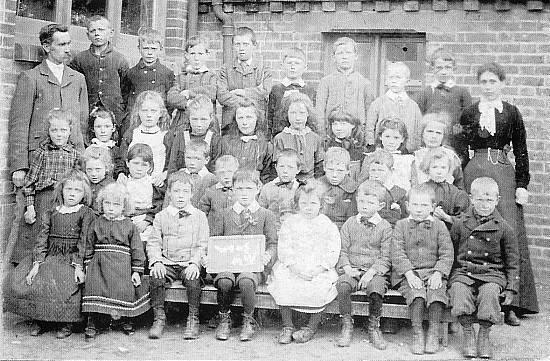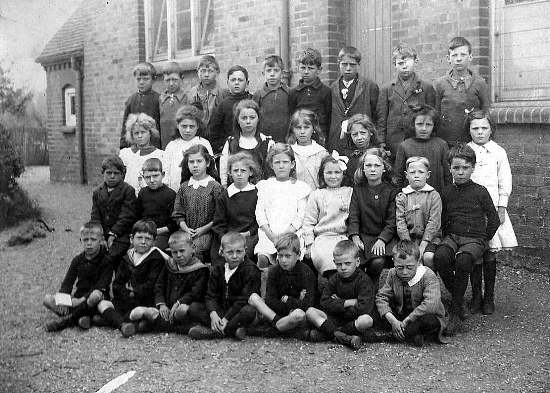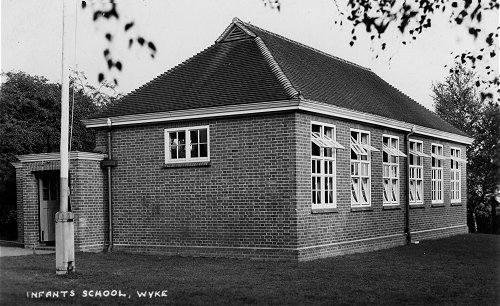For the impoverished, family life in Normandy during the early 1800s
was hard. It was a life-style to which families were accustomed. Church
service for the family on Sunday and afternoon Sunday school for the children
was a welcome break from the labours of the week. However, a chain of events
had started within the Church and central Government, that was to improve
the quality of the life of children. For in 1870 the Government finally
took the responsibility for the education of the country by introducing
compulsory education into England.
- In the beginning
- The present building complex, forming the school, has been built mainly
on land acquired in 1862 by Deed of Gift (for a consideration of five shillings),
from H M Chester and F J Chester of Poyle Park. A Trust Deed was executed
in January 1862 with the Vicar and Churchwardens of Wyke and their successors
as trustees for the building of a school and schoolhouse. No provision
was made by the deed for the management of the school. In 1878, The Reverend
Henry Drayton Wyatt made an application to the National Society "for
a building grant towards the erection of a new school, which was to replace
the present school held in a room that was now too small to accommodate
the numbers who wished to attend". The supporting statement indicated
that the room then used was sanctioned for 53 children with a register
of 70 wishing to attend. The room was in private property and the agreement,
under which it was held, expired 30 September 1879 and would not be renewed.
The application was approved and a grant of £45 made towards the
new school, designed by Henry Peak (Architect) and built by W Swayne (Builder)
at a cost of £555.9s.9d. Subscriptions raised from landed proprietors
and others fell short of the final cost by three shillings and three pence,
which The Reverend Wyatt was himself obliged to donate in order to make
the books balance. The school was up and running in October 1879.
The original L shaped school building consisted of two rooms. The smaller
one was for 60 infants, the other for 70 boys and girls of mixed academic
standards. Both rooms had poor natural ventilation and lighting. In winter,
the two rooms were terribly cold, the larger being heated from a single
combustion stove, quite inadequate for the size of the room. The infants'
room, the smaller one, had a fireplace and seating in fixed gallery formation.
In later years, about 1900, the workbenches of the manual evening classes
were stacked in the room during the day. The gallery was removed in July
1905 and replaced by desks. There were separate stepped entrances for the
boys, girls and infants. Each lobby was used as a cloakroom. In one, there
were three steps and two to each of the others. The infants often fell on
the steps and hurt themselves. Mr P F Story, an early surveyor of the school,
recommended in 1904 a sloped approach to the entrance lobbies. However,
users and visitors to the school over the decades, will be aware that no
such recommendation was ever adopted.
The play areas were separated, but a piece of ground to one side, covered
with gorse and in a very rough state, was used as a common playground. The
school site was enclosed partly by a post and wire fence, partly by a close-boarded
fence and partly by a hedge. It had practically no drainage at all, so consequently
the ground was often flooded in periods of heavy rain. Fresh drinking water
remained a problem until 1905, when the school acquired two four-gallon
jars, which the caretaker had to take each day to fill at Mr J Deedman's
well. The caretaker in 1905 received 30/- per week for all his duties.
Copying off the blackboard, working of sums, taking dictation and reproducing
the drawing from the object lesson was on slates using slate pencils. The
latter were often worn to short stubs, a practice hardly conducive to good
writing. Their use was less expensive than paper. Corrections were easily
made and so the practice continued for many years, but eventually was phased
out with the infants being the last to use slate and slate pencil.
Miss Cecilia White commenced her duties as Headteacher (Certificated)
of Wyke Church of England School on Monday 14 October 1882. Her predecessor,
Miss Sarah Elizabeth White (Uncertificated) was to remain as Assistant Teacher
until December 1883, when she married and sailed with her husband to India.
Miss Davies replaced her in April 1894. Miss Cecilia White was assisted
from time to time by a number of monitresses, older pupils able to teach
the infants, such as Ivy Goddard, Kate Grover and Elizabeth Bellinger, all
of whom were paid two shillings a week. Miss Davies departed for Puttenham
in the August and Miss Billson took her place.
Miss White's headship was short-lived for tragedy struck on Saturday
17 January 1885 "when she (Miss Cecilia White) met with a fatal accident
on the SE Rail near Ash Junction Station" as entered in the logbook
by The Reverend Henry Wyatt, Chairman of Managers.
The use of logbooks, to note daily happenings, was introduced into schools
in about 1862. It is possible that there was an earlier one than that started
by Miss Cecilia White in 1882. So, for the time being, earlier headteachers
of the school (other than Miss Sarah White) remain unknown, as do their
chronicles. Interestingly, the 1881 census for the Parish of Ash, Village
of Wyke, indicates that the schoolhouse was occupied by George Marshall
(Gardener) and the occupation of his wife was "schoolmistress".
It is reasonable to presume from Cecilia White's early recordings that
only families living in the immediate area of the school sent their children
to the school. Equally, it may be safe to assume that the school premises
were used for night school pupils as well as day pupils, since frequent
mention is made of "parties for the day pupils only". Often the
school was closed in the afternoon in order to prepare the larger of the
two rooms for an evening concert.
It was not uncommon for the school to close for long periods on account
of diphtheria, measles, whooping cough, scarlet fever and ringworm. In March
1885, whooping cough and measles was prevalent, forcing the managers of
the school to close it for two weeks. Early in 1891, scarlet fever raged
in the Willey Green area. Families in Bailes Lane were forbidden to send
their children to the school. Sadly, in August, Edith Northover died of
diphtheria and the Medical Officer of Health for the Farnham District, Dr
John A Lorrimer, recommended the closing of the school. In 1893 and again
on his instruction the school was closed for three weeks in May due to another
outbreak of diphtheria, in July for a further four weeks and again in November
for six weeks. By 22 January 1894 there had been 23 cases notified.

- Wyke School in the early 1900s
The class is Standard IV as indicated by the boy with the slate. The children
and mistress are unidentified but the master is James Blaber, the Headteacher.
Since the greater part of the income of the school was dependent on government
grants based on average attendance figures, the marking of the daily registers
were of paramount importance. A favourite excuse for being absent a week
at a time was for seasonal fruit picking. In July 1883, children picking
currants at Mr Parrott's Nursery, reduced the daily attendance average for
the week from about 90 to 50. No excuse was needed, however, to close the
school for the annual church choir outing in July of each year. These started
in about 1896 and continued until 1914, possibly then being discontinued
because of the outbreak of World War I.
.......... Click here to see Plan of the School
in 1933 Click here to see Plan of the School
in 1933
The generosity over the years of local dignitaries to children of Wyke
school has always been appreciated such as that by the Coussmaker family,
Colonel and Mrs Wavell and Lady Bright. Mrs Stevens, a manager's wife in
those early years, presented at Christmas to each girl a pair of scissors,
a knife to every boy in the upper school and two handkerchiefs to each infant.
The Halsey family and Lady Roberts invited the school to tea parties at
Henley Park. Also, Lady Roberts gave a bun and an orange to each child at
Christmas, between 1918 and 1923.

- Wyke School photo c.1923
Norah Goodchild is the third from the left on the second row from the front.
She was born 1st January 1912 so would be about 11 or 12 at the time. Her twin
brother, Harry Goodchild, is not in the photo so it's assumed that he'd
moved on to another school following his scholarship gained in July 1923.
- Of interest is Norah's school report
from Christmas 1925.
 Click
Here to see report. Click
Here to see report.
- But who are the other children?
- If you know any of the others in
this photo please let us know
In August 1934, the school was closed and work started on a new school building. Designed by Jarvis and Richards, Architects of London, was sited to the east and behind the schoolhouse. It comprised two classrooms, separate cloakrooms for boys and girls and a room for the teachers. The building has been known as the Infants School and more latterly as the Reception Classroom.

- Wyke School, Infant's Class Rooms c.1960
Although and allegedly, Britain was ill prepared for war in 1939, a scheme
of evacuation was tested at the school in September 1937 to see how long
it took teachers and pupils to clear the school buildings. All children
were off the premises in 30 seconds. In July 1939, everyone at the school
was instructed to bring their issued gas mask to school for the first time.
The air raid shelters in the school garden were occupied for the first time
in September 1940 and three teams of senior boys were trained to use stirrup
pumps to fight fires. As the years advanced to 1942, the sound of the air
raid warning was generally dreaded whereas the long continuous wail of "the
all clear" was a very welcome sound, although it could hardly be heard
in the shelter. A problem emerged later in 1942 as to how some children
could be protected in the daytime during the summer holiday when parents
were away from home on essential war work. In consultation with the Education
Authority and the school managers, Mr Smith arranged for the school to remain
open with attendant teachers on a roster system. A telephone, Normandy 2197,
was installed for the Local ARP (Air Raid Precautions) to give the teacher
early warning of an air raid. Mr Smith complained "that not only was
no warning given by phone, but neither was any message received by runner
from the local ARP post". A shelter remains on the school site forming
part of the south-western boundary.
Normandy had been generally unaffected by enemy air raids, despite its
proximity to Aldershot, the Home of the British Army. However, on 16 June
1944, five windows of the school were damaged by blast from enemy action.
Although there were other incidents around and about, life at the school
continued undisturbed until cessation of hostilities in May 1945 when the
school was closed for the VE Day (Victory in Europe) celebrations. |